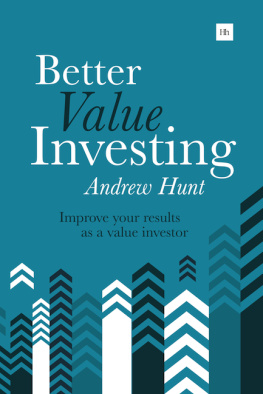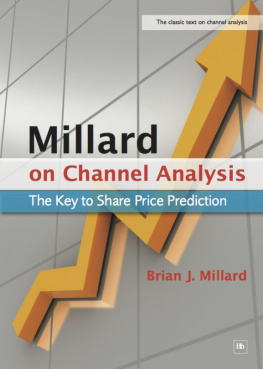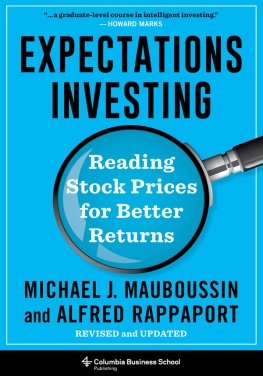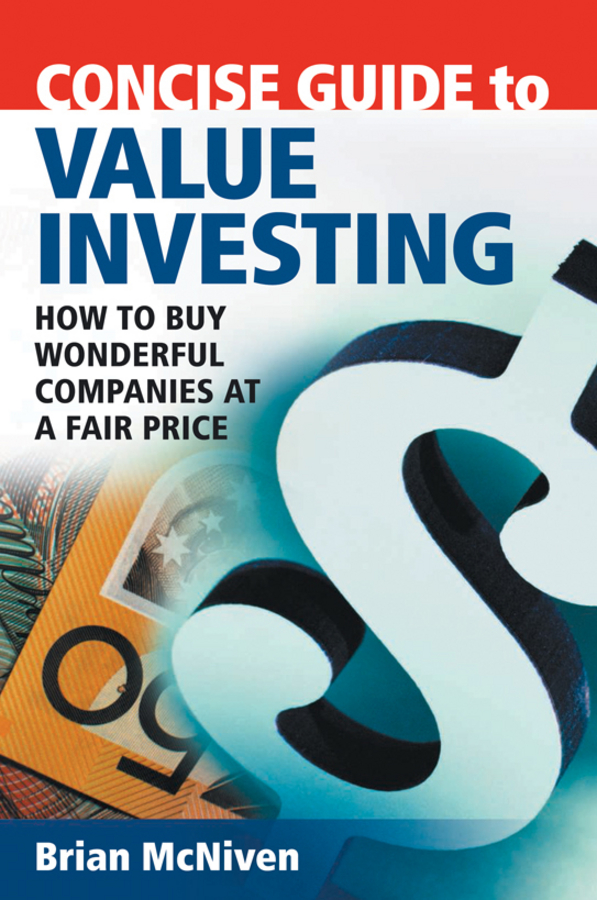Contents

Also by Brian McNiven:
A Wonderful Company at a Fair Price
Published by and available from Wrightbooks
First published 2008 by Wrightbooks
an imprint of John Wiley & Sons Australia, Ltd
42 McDougall Street, Milton Qld 4064
Office also in Melbourne
Typeset in 11.5/14.5 pt Warnock Pro
Brian McNiven 2008
The moral rights of the author have been asserted
National Library of Australia Cataloguing-in-Publication data:
Author: McNiven, Brian.
Title: Concise Guide to Value Investing / author, Brian McNiven.
Publisher: Richmond, Vic. : John Wiley and Sons, 2008.
ISBN: 9780731407934 (pbk.)
Notes: Includes index.
Subjects: Investments. Stocks. Corporations Valuation.
Dewey Number: 332.6
All rights reserved. Except as permitted under the Australian Copyright Act 1968 (for example, a fair dealing for the purposes of study, research, criticism or review), no part of this book may be reproduced, stored in a retrieval system, communicated or transmitted in any form or by any means without prior written permission. All inquiries should be made to the publisher at the address above.
All quotes from Warren Buffett and Charlie Munger are copyrighted and reproduced with permission.
Cover image Photodisc
Disclaimer
The material in this publication is of the nature of general comment only, and neither purports nor intends to be advice. Readers should not act on the basis of any matter in this publication without considering (and if appropriate taking) professional advice with due regard to their own particular circumstances. The author and publisher expressly disclaim all and any liability to any person, whether a purchaser of this publication or not, in respect of anything and of the consequences of anything done or omitted to be done by any such person in reliance, whether in whole or part, upon the whole or any part of the contents of this publication.
Preface
Although margin of safety (being the difference between price and value) is said to be the most important consideration of the worlds greatest investors, Warren Buffett and his partner Charlie Munger, what good is it to be told that with no explanation of how value is calculated? Its not surprising that Buffett himself remarked in 1985:
I have seen no trend toward value investing in the 35 years Ive practiced it. There seems to be some perverse human characteristic that likes to make easy things difficult.
I am more inclined to think that there is some perverse human characteristic that fails to see the connection between value investing and assessment of value. For instance: have you ever asked an investment adviser who recommends a stock on the basis that it represents good value what value he or she places on the stock and what numerical assumptions he or she used in arriving at that value? In the investment world, no other word is so often used and so little understood.
In likening stock valuation to the problem of solving the St Petersburg Paradox, even the accredited securities analyst Benjamin Graham avoided tackling the issue, favouring the more simplistic approach of considering the relation between price and book value.
Although the objective of all investors is to seek superior returns with minimal risk by acquiring stocks in wonderful businesses at a price that represents good value, if they do not know how to calculate value, the objective is achieved by chance, rather than design.
This book will help you reduce your risks and maximise your rewards by providing you with a thorough understanding of value investing and how to determine the true value of a company.
Brian McNiven
Gold Coast
February 2008
Chapter 1
What is value investing?
If we acknowledge that investing is the intention to seek a required rate of return (RR) relative to risk based on an assessment of value, then all investing is value investing. The deployment of capital in the absence of assessment of value is called speculation.
Although the art of speculation is covered by numerous books on stock trading and technical analysis, why is it necessary to use a tautology by including the word value in the title of a book on investing? After all, would it not be equally foolish to refer to a car as an automobile car or an ATM (automatic teller machine) as an ATM machine?
That the market sees value investing as different from normal investing implies that the very factor on which investing is based is little understood, and therefore nearly always ignored.
Value assessment does not rely on precision
Warren Buffett once said, Id rather be approximately right than precisely wrong. Stock valuation is subjective in that it requires a judgement of the sustainability of past profitability, and is therefore far from being an exact science. Like price, value will not increase in neat, even increments year after year, but will vary with the changing fortunes of the business.
The following commentary is typical of analysts who make buy/sell recommendations in the absence of quoting value and the business performance criteria on which they based their recommendation. One firm featured a leading article titled Be vaguely right, not precisely wrong. The reason for this play on Buffetts words was to justify their recommendations not being accompanied by an indication of value. Their argument that value infers precision and is therefore misleading would seem to nullify their claim to be experts on value investing. If value investing is not about assessment of value, then what is it? Presumably, being Vaguely right means using some other means to vaguely determine whether a stock should be bought or sold at its current price. How such a vague notion can be used to generate precise recommendations was not mentioned.
An assessment of value is determined by making forward assumptions of a businesss performance based on its historical performance. Depending on the current outlook for the business and its future prospects, the adopted performance criteria (APC) may differ from those that past performance indicates. One also needs to make an assessment of the RR to compensate for many factors, as discussed in chapter 6. The adopted assumptions are then used in the StockVal formula to calculate the value, the preciseness of which is not as important as being, as Buffett suggests, approximately right. As essential as valuation is in determining the margin of safety between value and price, other factors need to be considered when deciding whether a stock should be bought or sold.
The argument that value is misleading because it infers precision is as foolish as suggesting that real-estate valuations are a waste of time because they too imply precision.
A recommendation may be correct, but unless it is accompanied by evidence of value, it can be considered only an unjustified expression of opinion. Warren Buffett says, Wall Street is a place that people drive to in a Rolls Royce to get advice from people who ride to work on the subway.
Eddie Cantor once said, They told me to buy this stock for my old age and it worked perfectly. Within six months I felt like an old man.
Investing in stocks is not about buying scrip that will go up and down in price, but about investing long term in a sound business that represents good value at its current price.
So-called Value and growth stocks
One of the idiosyncrasies of stock market terminology is that it divides stocks into two separate categories: value and growth. Growth stocks are considered to be those whose low dividend yields are compensated for by high earnings per share (EPS) growth, while value stocks are deemed to have the opposite characteristics.








